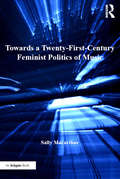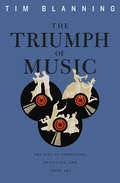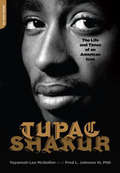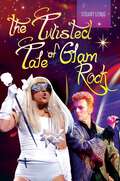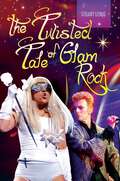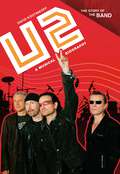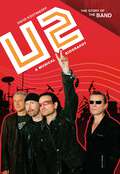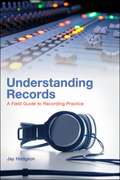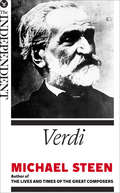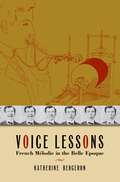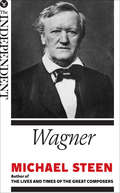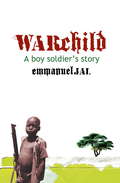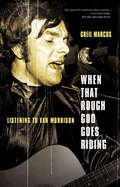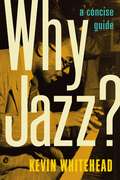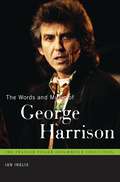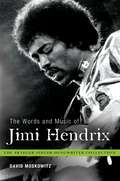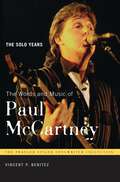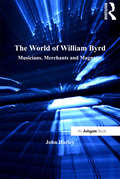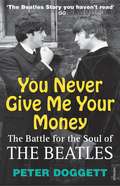- Table View
- List View
Towards a Twenty-First-Century Feminist Politics of Music
by Sally MacarthurTowards a Twenty-First-Century Feminist Politics of Music opens up a new way of thinking about the absence of women's music. It does not aim to find 'a solution' in a liberal feminist sense, but to discover new potentialities, new possibilities for thought and action. Sally Macarthur encourages us, with the assistance of Deleuze, and feminist-Deleuzian work, to begin the important work of imagining what else might be possible, not in order to provide answers but to open up the as yet unknown. The power of thought - or what Deleuze calls the 'virtual' - opens up new possibilities. Macarthur suggests that the future for women's 'new' music is not tied to the predictable and known but to futures beyond the already-known. Previous research concludes that women's music is virtually absent from the concert hall, and yet fails to find a way of changing this situation. Macarthur finds that the flaw in the recommendations flowing from past research is that it envisages the future from the standpoint of the present, and it relies on a set of pre-determined goals. It thus replicates the present reality, so reinforcing rather than changing the status quo. Macarthur challenges this thinking, and argues that this repetitive way of thinking is stuck in the present, unable to move forward. Macarthur situates her argument in the context of current dominant neoliberal thought and practice. She argues that women have generally not thrived in the neoliberal model of the composer, which envisages the composer as an individual, autonomous creator and entrepreneur. Successful female composers must work with this dominant, modernist aesthetic and exploit the image of the neo-romantic, entrepreneurial creator. This book sets out in contrast to develop a new conception of subjectivity that sows the seeds of a twenty-first-century feminist politics of music.
The Triumph of Music: The Rise of Composers, Musicians and Their Art
by Tim BlanningA distinguished historian chronicles the rise of music and musicians in the West from lowly balladeers to masters employed by fickle patrons, to the great composers of genius, to today’s rock stars. How, he asks, did music progress from subordinate status to its present position of supremacy among the creative arts? Mozart was literally booted out of the service of the Archbishop of Salzburg “with a kick to my arse,” as he expressed it. Yet, less than a hundred years later, Europe’s most powerful ruler—Emperor William I of Germany—paid homage to Wagner by traveling to Bayreuth to attend the debut of The Ring. Today Bono, who was touted as the next president of the World Bank in 2006, travels the world, advising politicians—and they seem to listen. The path to fame and independence began when new instruments allowed musicians to showcase their creativity, and music publishing allowed masterworks to be performed widely in concert halls erected to accommodate growing public interest. No longer merely an instrument to celebrate the greater glory of a reigning sovereign or Supreme Being, music was, by the nineteenth century, to be worshipped in its own right. In the twentieth century, new technological, social, and spatial forces combined to make music ever more popular and ubiquitous. In a concluding chapter, Tim Blanning considers music in conjunction with nationalism, race, and sex. Although not always in step, music, society, and politics, he shows, march in the same direction.
Tupac Shakur: The Life and Times of an American Icon
by Fred L. Johnson Tayannah Lee McQuillarA passionate, critically incisive cultural biography of hip-hop icon Tupac Shakur and an examination of the forces that shaped himIn 1996 Tupac Shakur, one of the most talented artists of his time, was murdered by an unknown gunman. Fred L. Johnson and Tayannah Lee McQuillar examine the theories surrounding his death and the story of Tupac's lost legacy in this definitive biography.For millions, Shakur gave voice to their stories, but there was also another side to him, revealed as his life spun out of control, as the whispered warnings from friends went unheeded and the denunciations of critics grew louder. Disturbingly, he sang and wrote about his impending death. When it came, it brought the music industry to its knees and ended an era when American rappers were leaders in using their art to speak the truth to corporate, government, and judicial power.
The Twisted Tale of Glam Rock
by Stuart LenigCovering four decades of music history, this engaging book explores a genre of pop music that has been overlooked, under-reported, and ineffectively characterized—but which nevertheless remains immensely popular.The very qualities that made glam unusual and undervalued are now being reintroduced into our culture through video, music, and cyber and computer mediums, while artists such as Lady Gaga have made glam popular once more. Carefully explaining this misunderstood genre, The Twisted Tale of Glam Rock explores glam's attraction and the reasons it has endured.With the help of copious examples, the book covers the style from the pre-glam British invasion of 1964-69 through the classical glam era (1970-75); the metamorphosis into glam goth, glam metal, and glam new-romanticism (1976-90); and the style's reemergence (1990-present). It provides a theoretical basis for musicians' attraction to this highly visual and theatrical form of pop music and sets glam in a historical context, following the format through MTV, videos, and vibrant stage and theatre presentations. Finally, the book explores the hybridization of glam with other styles, illustrating how the genre has progressively reemerged as a premier form of performance pop.
The Twisted Tale of Glam Rock
by Stuart LenigCovering four decades of music history, this engaging book explores a genre of pop music that has been overlooked, under-reported, and ineffectively characterized—but which nevertheless remains immensely popular.The very qualities that made glam unusual and undervalued are now being reintroduced into our culture through video, music, and cyber and computer mediums, while artists such as Lady Gaga have made glam popular once more. Carefully explaining this misunderstood genre, The Twisted Tale of Glam Rock explores glam's attraction and the reasons it has endured.With the help of copious examples, the book covers the style from the pre-glam British invasion of 1964-69 through the classical glam era (1970-75); the metamorphosis into glam goth, glam metal, and glam new-romanticism (1976-90); and the style's reemergence (1990-present). It provides a theoretical basis for musicians' attraction to this highly visual and theatrical form of pop music and sets glam in a historical context, following the format through MTV, videos, and vibrant stage and theatre presentations. Finally, the book explores the hybridization of glam with other styles, illustrating how the genre has progressively reemerged as a premier form of performance pop.
U2: A Musical Biography (The Story of the Band)
by David KootnikoffThis is the story of the phenomenally popular, critically acclaimed Irish band from its Dublin beginnings to the present.U2: A Musical Biography tells the story of the phenomenally popular Irish rock band whose passionate songs and performances have taken them from their Dublin upbringing to the Rock and Roll Hall of Fame—all with the band's original foursome of Bono, The Edge, Larry Mullen, and Adam Clayton intact.U2 follows the band from the early talent show victory that got them their first recording contract to their 1987 worldwide breakout with The Joshua Tree and the string of critically acclaimed albums and sold-out stadium and arena tours that followed. As the story of U2 unfolds, readers will get a sense of the strong interpersonal bonds and deep-rooted Christian faith that have kept the band together for over three decades. The book also highlights the group's ongoing commitment to supporting a variety of human rights causes worldwide.
U2: A Musical Biography (The Story of the Band)
by David KootnikoffThis is the story of the phenomenally popular, critically acclaimed Irish band from its Dublin beginnings to the present.U2: A Musical Biography tells the story of the phenomenally popular Irish rock band whose passionate songs and performances have taken them from their Dublin upbringing to the Rock and Roll Hall of Fame—all with the band's original foursome of Bono, The Edge, Larry Mullen, and Adam Clayton intact.U2 follows the band from the early talent show victory that got them their first recording contract to their 1987 worldwide breakout with The Joshua Tree and the string of critically acclaimed albums and sold-out stadium and arena tours that followed. As the story of U2 unfolds, readers will get a sense of the strong interpersonal bonds and deep-rooted Christian faith that have kept the band together for over three decades. The book also highlights the group's ongoing commitment to supporting a variety of human rights causes worldwide.
Understanding Mozart's Piano Sonatas
by John IrvingMozart's piano sonatas are among the most familiar of his works and stand alongside those of Haydn and Beethoven as staples of the pianist's repertoire. In this study, John Irving looks at a wide selection of contextual situations for Mozart's sonatas, focusing on the variety of ways in which they assume identities and achieve meanings. In particular, the book seeks to establish the provisionality of the sonatas' notated texts, suggesting that the texts are not so much identifiers as possibilities and that their identity resides in the usage. Close attention is paid to reception matters, analytical approaches, organology, the role of autograph manuscripts, early editions and editors, and aspects of historical performance practice - all of which go beyond the texts in opening windows onto Mozart's sonatas. Treating the sonatas collectively as a repertoire, rather than as individual works, the book surveys broad thematic issues such as the role of historical writing about music in defining a generic space for Mozart's sonatas, their construction within pedagogical traditions, the significance of sound as opposed to sight in these works (and in particular their sound on fortepianos of the later eighteenth-century) , and the creative role of the performer in their representation beyond the frame of the text. Drawing together and synthesizing this wealth of material, Irving provides an invaluable reference source for those already familiar with this repertoire.
Understanding Mozart's Piano Sonatas
by John IrvingMozart's piano sonatas are among the most familiar of his works and stand alongside those of Haydn and Beethoven as staples of the pianist's repertoire. In this study, John Irving looks at a wide selection of contextual situations for Mozart's sonatas, focusing on the variety of ways in which they assume identities and achieve meanings. In particular, the book seeks to establish the provisionality of the sonatas' notated texts, suggesting that the texts are not so much identifiers as possibilities and that their identity resides in the usage. Close attention is paid to reception matters, analytical approaches, organology, the role of autograph manuscripts, early editions and editors, and aspects of historical performance practice - all of which go beyond the texts in opening windows onto Mozart's sonatas. Treating the sonatas collectively as a repertoire, rather than as individual works, the book surveys broad thematic issues such as the role of historical writing about music in defining a generic space for Mozart's sonatas, their construction within pedagogical traditions, the significance of sound as opposed to sight in these works (and in particular their sound on fortepianos of the later eighteenth-century) , and the creative role of the performer in their representation beyond the frame of the text. Drawing together and synthesizing this wealth of material, Irving provides an invaluable reference source for those already familiar with this repertoire.
Understanding Records: A Field Guide To Recording Practice
by Jay HodgsonRecording Practice is musical practice, a technical but artistic affair. Understanding Records explains the musical language of Recording Practice in a way that any interested reader can understand. Drawing on readily available hit records produced since 1945, each section of this book explains a handful of core production and engineering techniques in chronological record-making sequence, elucidating how those techniques work, what they sound like, how they function musically, where listeners can hear those techniques at work in the broader Top 40 soundscape, and where they fit in the broader record-making process at large.
Understanding Records: A Field Guide To Recording Practice
by Jay HodgsonRecording Practice is musical practice, a technical but artistic affair. Understanding Records explains the musical language of Recording Practice in a way that any interested reader can understand. Drawing on readily available hit records produced since 1945, each section of this book explains a handful of core production and engineering techniques in chronological record-making sequence, elucidating how those techniques work, what they sound like, how they function musically, where listeners can hear those techniques at work in the broader Top 40 soundscape, and where they fit in the broader record-making process at large.
Verdi: The Great Composers (The Great Composers)
by Michael SteenWelcome to The Independent’s new ebook series The Great Composers, covering fourteen of the giants of Western classical music. Extracted from Michael Steen’s book The Lives and Times of the Great Composers, these concise guides, selected by The Independent’s editorial team, explore the lives of composers as diverse as Mozart and Puccini, reaching from Bach to Brahms, set against the social, historical and political forces which affected them, to give a rounded portrait of what it was like to be alive and working as a musician at that time. With Verdi, Italian opera reached its zenith, where music and drama are fused into an indissoluble whole. Although he wrote 28 operas, less than half remain regularly performed. Yet those which are remain a gold standard of characterisation, stagecraft and musical vocabulary. Rigoletto, La Traviata, Un Ballo in Maschera, Aïda – the roll call is long, but it is especially with his final two operas, Otello and Falstaff, that he becomes the unassailable master. But it was not just the excellence of Verdi's artistry which propelled him to fame. Verdi was writing just as Italy was becoming increasingly resentful of Austria's domination, and there was a growing movement to unite the patchwork of territories of which Italy was composed at the time into a unified country. He became identified with the ambitions of reunification, and many of his operas, with their political subtexts, became rallying calls for the nationalists. Michael Steen unpicks how this most unsociable of men, a reluctant politician but a brilliant composer, became the figurehead for the birth of a nation. Born into a modest background, Verdi, with his sound business sense, grew rich and famous; rich enough to ignore the scandalised disapproval of his neighbours at his living openly with his mistress for many years before marrying her. At his death 200,000 people lined the streets to bid farewell to their hero.
Voice Lessons: French Mélodie in the Belle Epoque (New Cultural History of Music)
by Katherine BergeronLanguage, education, politics, and music come together in Katherine Bergeron's Voice Lessons, a study of the French mélodie in the Belle Epoque. Close readings of songs by Fauré, Debussy, and Ravel, along with poems, sound recordings, and other historical documents, seek to uncovers the cultural meanings of this art: why it emerged, why it mattered, and why it eventually disappeared.
Wagner: The Great Composers (The Great Composers)
by Michael SteenWelcome to The Independent’s new ebook series The Great Composers, covering fourteen of the giants of Western classical music. Extracted from Michael Steen’s book The Lives and Times of the Great Composers, these concise guides, selected by The Independent’s editorial team, explore the lives of composers as diverse as Mozart and Puccini, reaching from Bach to Brahms, set against the social, historical and political forces which affected them, to give a rounded portrait of what it was like to be alive and working as a musician at that time. No other composer is at once so revered or so reviled as Richard Wagner. Yet his contribution to opera is immense. His reputation rests on ten epic operas which are constantly performed worldwide, without speaking of the annual festival of his music at Bayreuth, the opera house which he designed and built to stage his works. Four of these operas, Das Rheingold, Die Walküre, Siegfried and Gotterdammerung, make up the monumental 15-hour Ring cycle, based on old Norse-Germanic sagas. Many of the others hark back to medieval and Arthurian legends, often dramatising the conflict between the sacred and profane, the sensual and spiritual. Using leitmotifs – themes which symbolise characters and elements in his opera – Wagner introduced a new musical vocabulary. Endless affairs, twice married, constantly on the run for either political or financial reasons, a prolific writer, an indefatigable composer, Wagner was also, as Michael Steen's narrative shows, a monster of egoism. A revolutionary in his youth, Wagner escaped to Zurich, only to be forced to move on when the businessman bankrolling him was about to uncover Wagner's affair with his wife. He was then lavishly supported in Munich by the ‘Mad King’ Ludwig II of Bavaria, until the king's ministers objected. Once in Switzerland, Wagner was joined by Cosima von Bülow, Liszt's daughter and the wife of a conductor, who became his second wife and helped him realise his dream at Bayreuth.
The Wanted: The Unauthorized Biography
by Chas Newkey-BurdenMax George, Siva Kaneswaran, Tom Parker, Nathan Sykes and James McGuiness topped the UK charts within a week of the release of their first single 'All Time Low'. With two number one hits under their belts, as well as polished performances and cheeky group camaraderie, The Wanted are synonymous with young, cool and successful. After facing gruelling mass-auditions to be part of the band, the five boys moved into a flat together in London, where they quickly developed a strong bond. Now perfecting their third studio album, featuring collaborations with Dappy, Chris Brown and Rita Ora this is The Wanted's most ambitious project yet. With worldwide fame now so firmly in their sights, this uber cool boyband has taken the charts by storm - and has won the hearts of millions of fans in the process. The amazing and inspirational story of how The Wanted have risen to stardom, as well as fascinating details about each of the boys and their backgrounds, is set to be a gripping reading for their growing number of fans.
War Child: A Boy Soldier's Story
by Emmanuel JalEmmanuel Jal was only seven years old when he was taken from his family home to become a child soldier with the rebel army in Sudan's bloody civil war for nearly five years. Beaten, starved and brutalised Emmanuel was put into battle in Ethiopia and southern Sudan carrying an AK-47 talller than himself.He attempted to leave the SPLA but was hunted down and thrown into a desert prison. He finally escaped and is now an internationally-acclaimed rap artist spreading messages of peace and reconciliation with his unique style of gospel rap.
When That Rough God Goes Riding: Listening to Van Morrison
by Greil MarcusThis book is a quest to understand Van Morrison's particular genius through a close look at the most extraordinary and unclassifiable moments in his long career, beginning in 1965 and continuing in full force to this day: sometimes entire songs, sometimes single words or even the guttural spaces between words that become musical events in themselves.
Why Jazz?: A Concise Guide
by Kevin WhiteheadWhat was the first jazz record? Are jazz solos really improvised? How did jazz lay the groundwork for rock and country music? In Why Jazz?, author and NPR jazz critic Kevin Whitehead provides lively, insightful answers to these and many other fascinating questions, offering an entertaining guide for both novice listeners and long-time fans. Organized chronologically in a convenient question and answer format, this terrific resource makes jazz accessible to a broad audience, and especially to readers who've found the music bewildering or best left to the experts. Yet Why Jazz? is much more than an informative Q&A; it concisely traces the century-old history of this American and global art form, from its beginnings in New Orleans up through the current postmodern period. Whitehead provides brief profiles of the archetypal figures of jazz--from Louis Armstrong and Duke Ellington to Wynton Marsalis and John Zorn--and illuminates their contributions as musicians, performers, and composers. Also highlighted are the building blocks of the jazz sound--call and response, rhythmic contrasts, personalized performance techniques and improvisation--and discussion of how visionary musicians have reinterpreted these elements to continually redefine jazz, ushering in the swing era, bebop, cool jazz, hard bop, and the avant-garde. Along the way, Why Jazz? provides helpful plain-English descriptions of musical terminology and techniques, from "blue notes" to "conducted improvising." And unlike other histories which haphazardly cover the stylistic branches of jazz that emerged after the 1960s, Why Jazz? groups latter-day musical trends by decade, the better to place them in historical context. Whether read in self-contained sections or as a continuous narrative, this compact reference presents a trove of essential information that belongs on the shelf of anyone who's ever been interested in jazz.
The Words and Music of George Harrison (The Praeger Singer-Songwriter Collection)
by Ian InglisThis book offers a comprehensive assessment of the music of George Harrison, revealing him as one of the most gifted and authentic singer-songwriters of his generation.The Words and Music of George Harrison is an in-depth appreciation of this often underappreciated musician, following Harrison's development as a singer-songwriter from his earliest songs with The Beatles through his final album, Brainwashed, released after his 2001 death from brain cancer.The Words and Music of George Harrison sheds new light on Harrison's 40-year career, examining his music output in the context of the enormous personal and professional changes he underwent, from the early days in Liverpool and the global explosion of Beatlemania through a solo career marked by spiritual concerns, political activism, and high-profile collaborations. As the book shows, at every stage, George Harrison's songs posed questions, provided commentaries, and looked for solutions, with results that add up to a remarkable music legacy.
The Words and Music of Jimi Hendrix (The Praeger Singer-Songwriter Collection)
by David V. MoskowitzThis comprehensive discussion of the singer/songwriter/guitarist's life carves autobiographical details from the lyrics of his song catalog.Jimi Hendrix was a rock 'n' roll guitar god and remains an important rock icon, still popular despite the four decades that have passed since his death in 1970. The Words and Music of Jimi Hendrix uses Hendrix's music—including the posthumous album Valleys of Neptune, released on March 9, 2010—to shed light on the details of the singer/songwriter's all-too-brief life.Organized chronologically, the book provides an in-depth look at Hendrix's life, carving autobiographical details from his lyrics. At the same time, it offers readers a better understanding of the superstar's music and the forces behind it. The book focuses on the three albums released during Hendrix's life, as well as the major posthumous works. Priority is also given to touring and to the influence of other guitarists.
The Words and Music of Paul McCartney: The Solo Years (The Praeger Singer-Songwriter Collection)
by Vincent P. Jr.This examination of the solo music of Paul McCartney, from 1970-2007, offers an analysis of his songs, recordings, and his impact on popular music.The Words and Music of Paul McCartney: The Solo Years examines the large and varied oeuvre of this deeply personal artist, showing how McCartney's stint as a Beatle continues to inform his solo music, as well as how he has transcended his days as a member of the Fab Four. After a biographical introduction, chronologically arranged chapters explore McCartney's music in the immediate aftermath of the breakup of the Beatles, his work with Wings during the 1970s, his collaborations with other artists during the 1980s, and his compositions of the 1990s, including his first forays into classical music. The examination also covers McCartney's critically acclaimed work in the first decade of the 21st century, including Memory Almost Full and Ecce Cor Meum, a composition written in the style of sacred English choral music. Throughout, the book supplies analytical insights and historical background to a repertoire that, surprisingly, has not previously been covered in detail.
The World of William Byrd: Musicians, Merchants and Magnates
by John HarleyIn The World of William Byrd John Harley builds on his previous work, William Byrd: Gentleman of the Chapel Royal (Ashgate, 1997), in order to place the composer more clearly in his social context. He provides new information about Byrd's youthful musical training, and reveals how in his adult life his music emerged from a series of overlapping family, business and social networks. These networks and Byrd's navigation within and between them are examined, as are the lives of a number of the individuals comprising them.
The World of William Byrd: Musicians, Merchants and Magnates
by John HarleyIn The World of William Byrd John Harley builds on his previous work, William Byrd: Gentleman of the Chapel Royal (Ashgate, 1997), in order to place the composer more clearly in his social context. He provides new information about Byrd's youthful musical training, and reveals how in his adult life his music emerged from a series of overlapping family, business and social networks. These networks and Byrd's navigation within and between them are examined, as are the lives of a number of the individuals comprising them.
You Never Give Me Your Money: The Battle For The Soul Of The Beatles
by Peter DoggettWhen Paul McCartney told the world in 1970 that he had no plans to work with the Beatles again, it was widely viewed as a cultural tragedy by the media and public alike. But one of the most fascinating phases of the Beatles' story was just about to begin. Now, for the first time, You Never Give Me Your Money tells the dramatic story of the Fab Four post 1969. It charts the almost Shakespearean rivalry of the Lennon and McCartney families, the conflict in George Harrison's life between spirituality and fame, and Richard Starkey's efforts to conquer his personal demons. It also chronicles the transformation of their multi-media company, Apple Corps, from a bastion of 1960s counter-culture into a corporate behemoth. From court battles to chart success, the best of rock'n'roll writers, Peter Doggett traces the untold story of a group and a legacy that will never be forgotten.
Flaming Lips' Zaireeka (33 1/3)
by Mark RichardsonZaireeka is the anti-headphone and the anti-mp3. It purposely makes the two biggest developments in end-user music in the last 30 years irrelevant. Zaireeka is not mobile. It is not personal. It is not solitary, cannot be easily controlled, and can't easily be consumed in small doses. So another way to think of Zaireeka is as a one-off piece of technology that comes in a highly inconvenient dead-end format. The Flaming Lips' 1997 album Zaireeka is one of the most peculiar albums ever recorded, consisting of four CDs meant to be played simultaneously on four CD players. Approaching this powerful and complex art-rock masterpiece from multiple angles, Mark Richardson's prismatic study of Zaireeka mirrors the structure the work itself. Thoughts on communal listening and the "death of the album" are interspersed with the story of the Zaireeka's creation (with assistance from Wayne Coyne) and an in-depth analysis of the music, leading to a complete picture of a record that proved to be a watershed for both the band and adventurous music fans alike.
